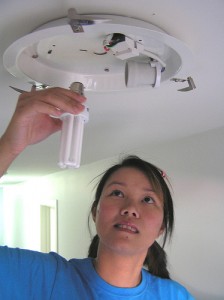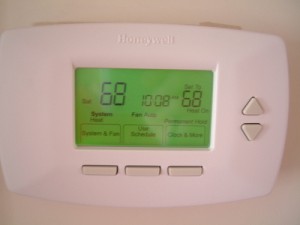
Energy Refuge caught up with Anthony Domel from Chicago-based Energy Results, a company that provides energy efficiency solutions, to find out what we can do to save energy.
ER: What is the single most significant action anyone could take to save energy?
AD: There are many levels of energy efficient upgrades and that every step in the green direction helps. When it comes to significant action, it is important to remember that there are many low cost and high impact upgrades that exist to save energy without breaking the bank.
Two very important areas where this type of low (or lower) cost, high impact upgrade exists are lighting and heating and cooling. Upgrading from incandescent light bulbs to CFLs throughout your home can save up to $140 per year, and the payback period for your investment is only about a year. Additionally, CFLs last nearly ten times longer than incandescent bulbs.
Similarly, programmable thermostats ensure that no energy is being wasted on heating or cooling your home when it is not necessary to do so. They can save you up to $94 each year and will pay for itself in about a year as well. Like we’ve said, little things can go a long way.
On the other hand, maybe you want to do a little more to ensure lasting efficiency. When it comes to bigger projects that have a huge impact, improving your home’s envelope by improving insulation and making sure your home is weatherized are very effective means to keep efficiency up.
While these steps are obviously more expensive than simply changing bulbs, they have a huge payback in reductions when it comes to energy bills and can save you up to $579 every year. Improving your homes envelope will likely pay for itself in a ten-year period. Whether you want to make a big change or a small improvement, there is always an option for you to make your home more energy efficient.
ER: How energy efficient is the average American household?
AD: It is difficult to designate any home as the average home in energy efficiency due to the fact that every household differs from others in a variety of factors that affect older homes tend to be much more inefficient than ones that were built more recently. Geography also leads to a big variation in levels of efficiency. For this reason, it becomes necessary to look at the situation from a different perspective: one in which these households are arranged on a scale ranging from the least energy efficient home to a highly efficient one.
We will take a sample home that represents what we believe to be a pretty average American household – let’s say a 2,000 square foot, two-story home with an attic, unfinished basement, and five residents – and give it the characteristics necessary to fall into the moderately efficient home category. These characteristics include an electric stove, appliances purchased around 2003, and double pane windows, as well as incandescent light bulbs, and non-Energy Star fans. This home is considered average and moderately efficient since it contains both green and non-green elements.
Now with a specific moderately efficient home in mind, it becomes possible to actually generate what is called the average savings potential. Essentially what you are doing to measure the energy efficiency of a home is to figure out how much can be saved by energy efficient upgrades. With a moderately efficient home with efficient and non-efficient components, we estimate a savings potential of $771.00 per year.
This estimate falls in between the estimate of $2,906 for the least efficient home and the near zero average savings potential of the most green household. While monetary value seems to be one of the most popular ways of displaying the concept of average savings potential, we also recognize that this amount also exists in other measurements.
In this sense, we have also estimated that the average American, moderately efficient household offsets 490 trees per year as estimated from its carbon output. While this estimate is by no means exact, it has been generated by the combination of energy savings data in areas ranging from the electric system, the water system, the home envelope, and the heating and cooling system in a home.
With the integration of these factors, we believe we have created an accurate estimate of the energy efficiency of the average American home.

AD: Energy Results helps homeowners create an all-around energy savings plan that is customized for their specific needs and then helps them to put this into action. I say that the service that we provide is all-around because we try to assist the customer in the process of becoming more energy efficient from start to finish.
We believe that road to energy efficiency is comprised of some very specific steps to ensure homeowners beneficial, lasting results. These steps include education, recommendations, and execution.
The first part of the process as mentioned above is important in that it offers homeowners a detailed energy audit report that is uniquely created from their specific home conditions and energy consumption values. The way that a homeowner goes about doing this is through our Virtual Home Energy Auditâ„¢ software which is completely free and can be found at our website.
By inputting information regarding such topics as appliances, house size, and in-home heating and cooling, a homeowner is able to calculate their average savings potential and a list of recommendations and upgrades specific to their household that increase the energy efficiency of their home.
These recommendations range from swapping incandescent light bulbs or high flow showerheads for more efficient models to installing a more efficient clothes washer or refrigerator. We aim to make homeowners aware of the fact that energy efficiency can be achieved at a variety of different levels and that it is possible to reduce your average savings potential in a variety of ways.
With a solid idea of how they can optimize their home’s efficiency, the homeowner also has the capability of implementing their unique energy efficiency plan by directly obtaining the products and services that were recommended to them through our Virtual Home Energy Audit™ software.
Homeowners can browse our complete catalog of energy efficient products with categories ranging from: appliances, lighting and fixtures, heating and cooling, home envelope, plumbing and water, and smart energy devices. If they decide that they want to know more about decreasing their savings potential, we also offer services such as free service estimates and professional home energy audits.
ER: Have you got any estimates as to how much we could save in emissions if we all became more energy efficient?
AD: Given that no two homes are the same when it comes to energy efficiency levels and average savings potential, it becomes useful to once again rely upon our estimate for the savings potential of an average American household.
Therefore, if we assume that energy efficient upgrades can improve efficiency by 25-30%, we estimate that the equivalent of carbon dioxide output that would be reduced each year would be about 6811 pounds of CO2 per household. This number multiplied by the estimated 130 million households in the United States gives us about 443 million tons of CO2 in average savings potential each year. This would be equal to planting nearly 64 billion trees every year. With that in mind, the total savings potential of 443 million tons of CO2 each year would amount to about 6% of the total United States carbon dioxide emissions.
Additionally, the total amount of carbon dioxide emissions per person included in this estimation likely includes transportation as a source of carbon dioxide output, which is not accounted for in a home energy audit to determine savings potential. As a result, the savings potential percentage for household specific activities will be higher than the estimated 6%.
You should follow us here.






There are some great points made here about energy and water efficiency. A common element that is certainly related but not focused on as much is indoor air quality. While families should be concerned about the efficiency of their homes due to its impact on the environment and their wallets, the same can be said about air quality. Our homes and buildings create their own environment inside and this indoor air quality is often many times more polluted than outside. People need to think about the products they use in their homes from the furniture and cabinet work to the type of paint and stains. Regular maintenance of your HVAC system can not only help to maintain its efficiency but also the air quality. Poor air quality can greatly impact your health which in turn will raise your health care costs. It’s important to look for low- or no-VOC products as well as those products that don’t include added urea-formaldehyde.
I couldn’t refrain from commenting. Exceptionally well written!